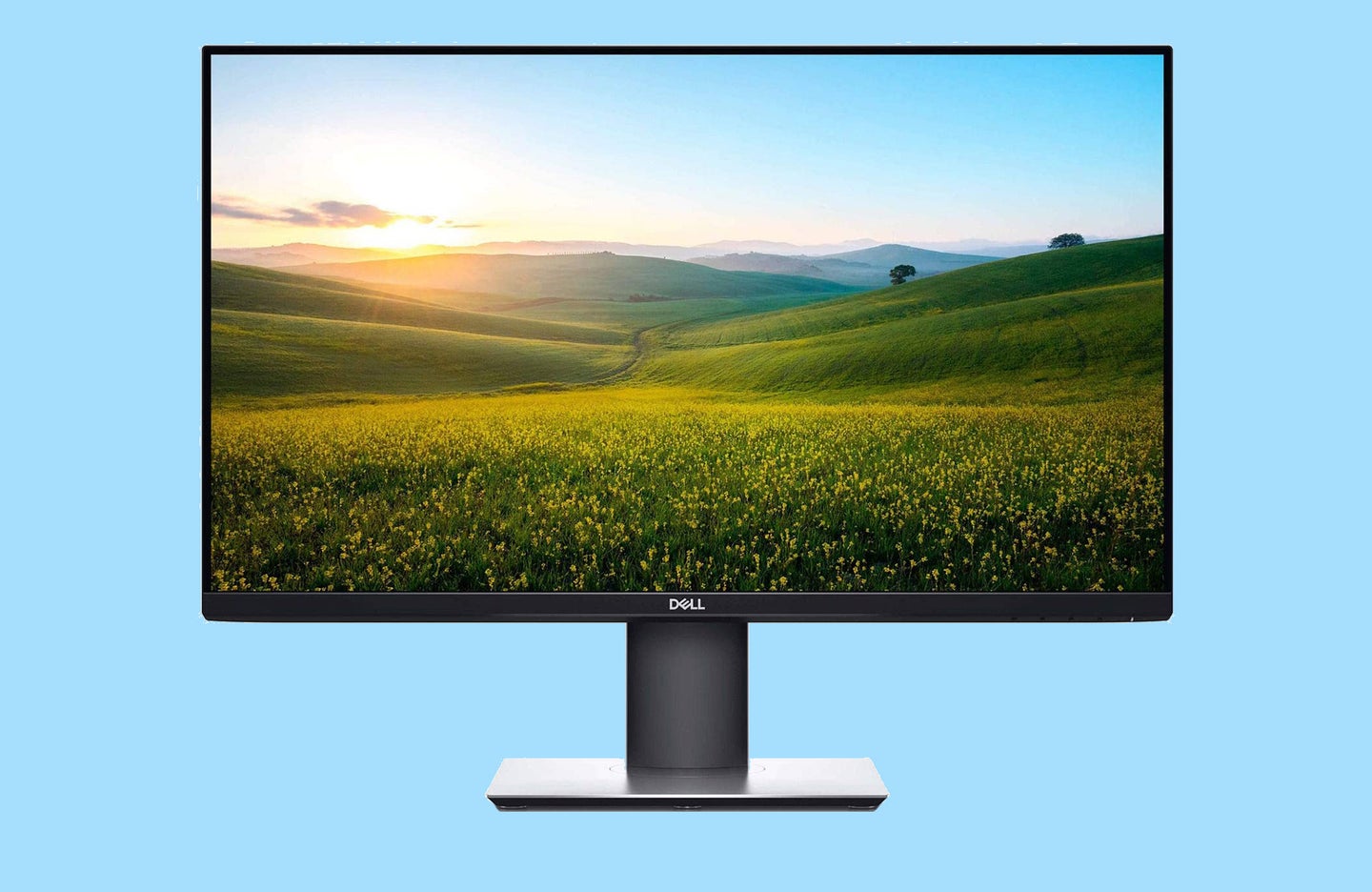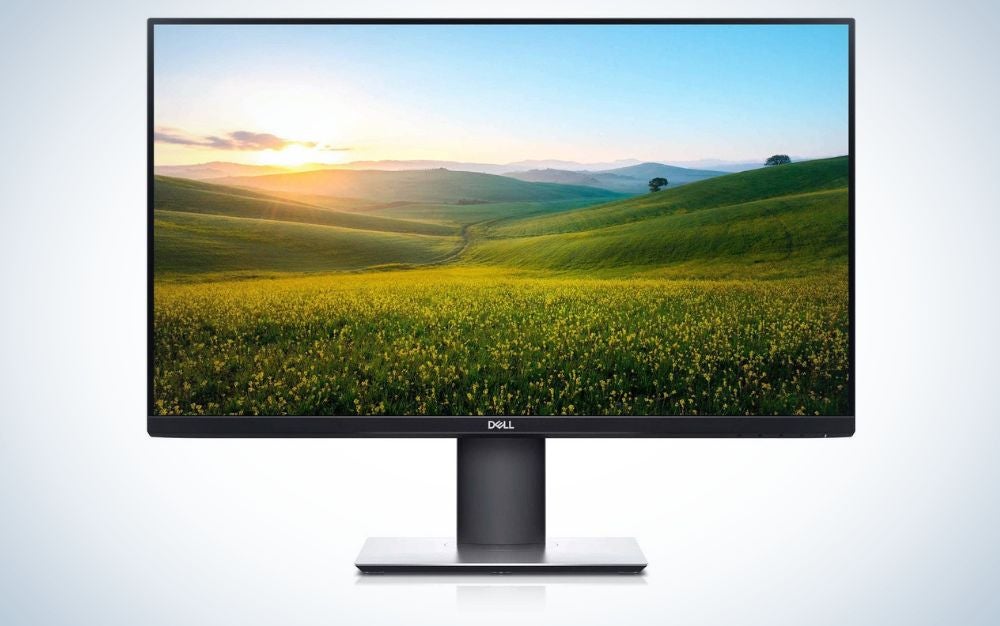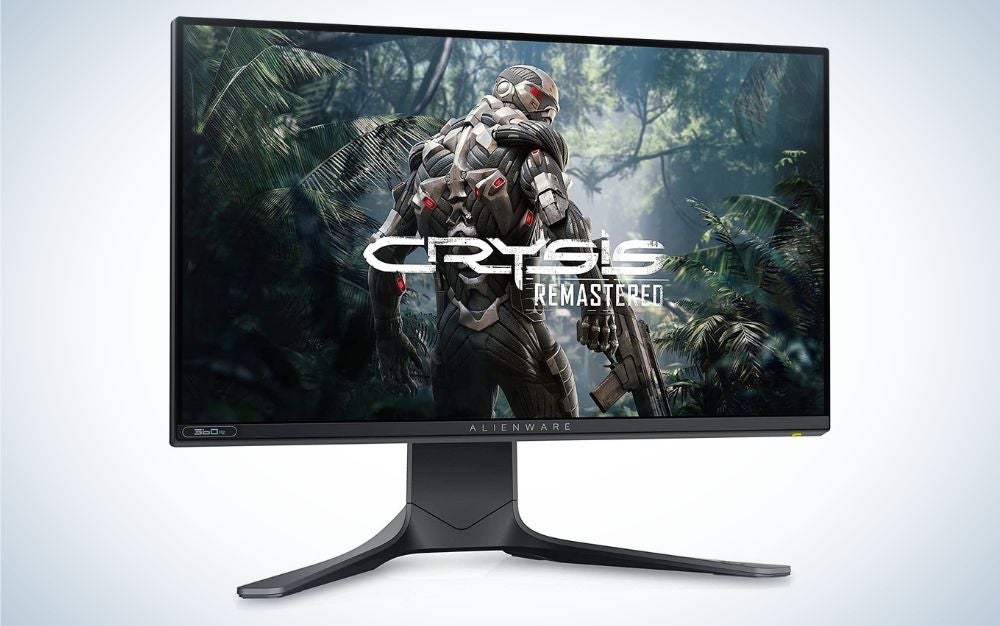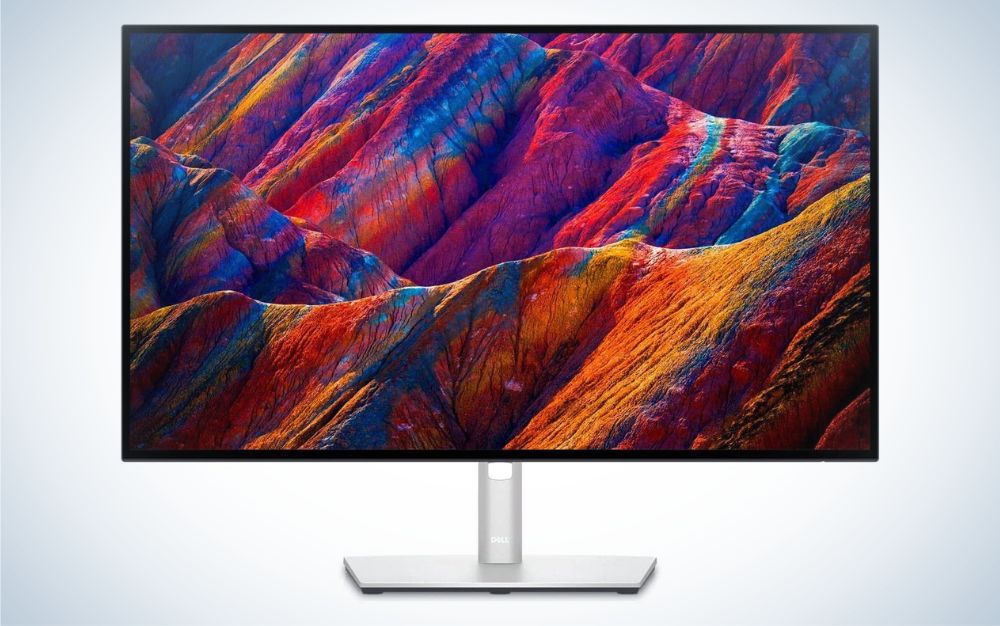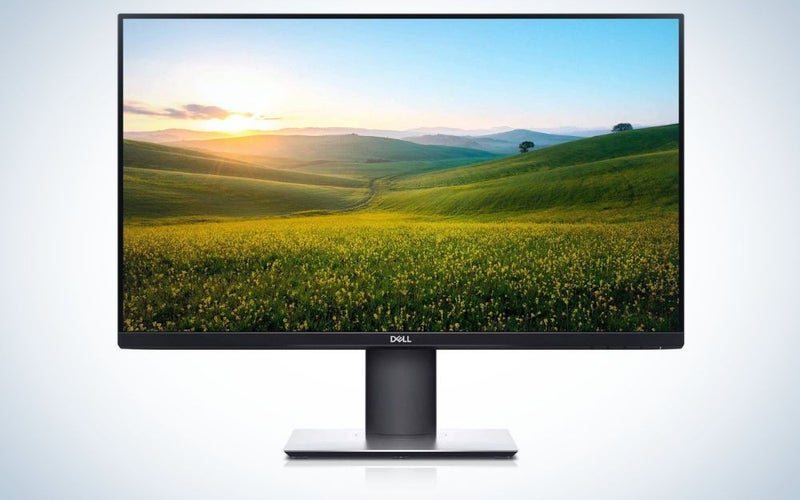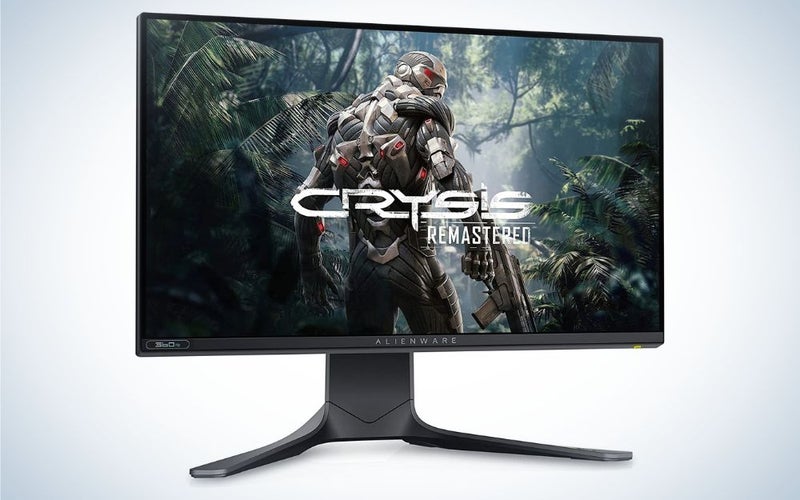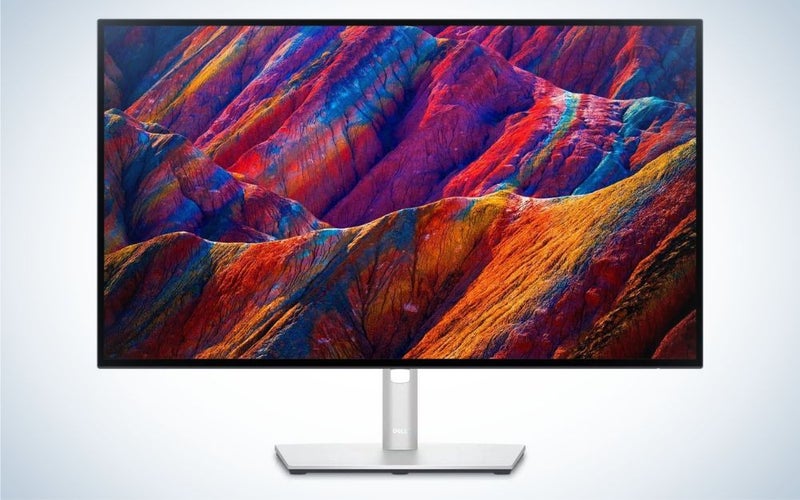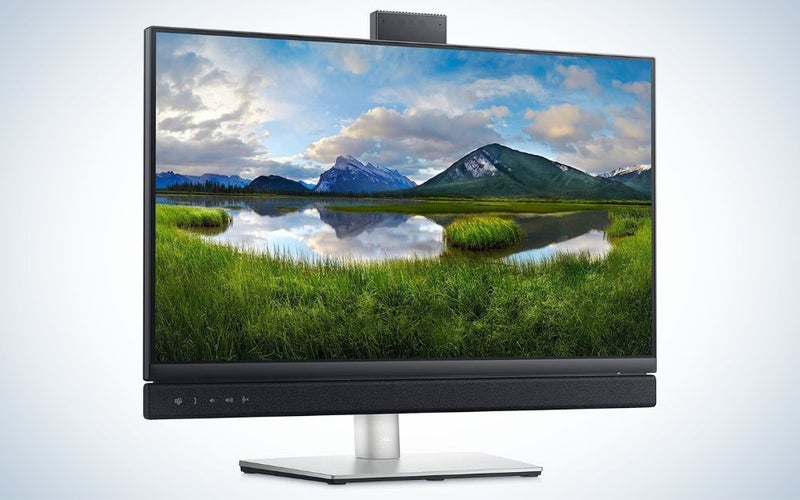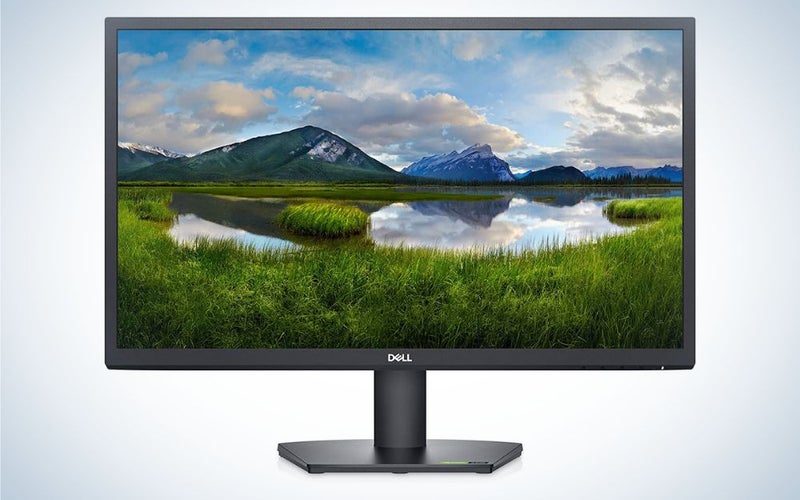We may earn revenue from the products available on this page and participate in affiliate programs. Learn more ›
Dell monitors may seem like an afterthought compared to its computers, but the company makes some truly excellent displays that deserve consideration. Dell’s offerings come with adjustable stands that enable you to set up a more ergonomic viewing angle, which is a huge plus and may save you from purchasing an expensive dedicated stand. It also offers reliable, well-designed pieces of equipment that should last you for a long time. The company’s lineup includes dozens of different models, all with their own strengths and weaknesses. They run the gamut from entry-level screens to pro-grade displays. No matter how you plan to use your screen, the best Dell monitors will meet your needs and improve your display setup.
- Best overall: Dell P2720D
- Best for gaming: Alienware AW2521H 360Hz Gaming Monitor
- Best for photo editing: Dell UltraSharp U2723QE
- Best for work: Dell 24 Video Conferencing Monitor C2422HE
- Best budget: Dell SE2422HX
How we chose the best Dell monitors
The writers and editors at Pop Photo have decades of experience in just about every genre and area of photography. Part of being a photographer inevitably involves staring at screens for long periods of time, which has helped provide an understanding of the characteristics necessary in a good monitor. When selecting the monitors on this list we prioritized different Dell lines that it designed for all sorts of use cases. After selecting the different product lines, we focused on resolution, contrast, color accuracy, and stand ergonomics. Price was also a consideration, as monitor prices can get expensive, making them out of reach for many.
The best Dell monitors: Reviews & Recommendations
Best overall: Dell P2720D
Dell
Why it made the cut: It’s a well-rounded monitor for a wide variety of users with QHD resolution, 60 Hz refresh rate, and 99% sRGB color coverage.
Key features
- Display size: 27 inches
- Resolution: 2560 x 1440 pixels
- Max refresh rate: 60 Hz
- Panel type: IPS
Pros
- Very adjustable stand
- Wide selection of connection ports
- Can easily daisy-chain to a second monitor
- Can charge a laptop through the monitor
Cons
- Lacking in coverage of Adobe RGB
The Dell P2720D strikes an excellent balance between different features and price, making it the ideal option for those who tackle all sorts of tasks and activities with their monitor. It has a resolution of 2560 x 1440, which is plenty even for watching movies and doing some photo editing. The 60 Hz refresh rate won’t be high enough for serious gamers, but it will be sufficient for most applications.
One of the biggest assets of this monitor is the large number of ports it has. You get four USB ports–two USB 3.0 and two USB 2.0–which you can use for both charging devices and connecting peripherals. There is one USB-C port that supports DisplayPort and offers power delivery up to 65 watts, and also one HDMI 1.4. And it has two DisplayPort 1.2 ports, one of which is for easily daisy-chaining a second monitor. If you want multiple displays, the P2720D makes it simple to configure.
This monitor has excellent color accuracy for the price and for the intended use, with 99% of sRGB covered. However, it is lacking a bit for situations that rely heavily on color accuracy, only covering roughly 78% of the wider Adobe RBG color space. The 1000:1 Static Contrast Ratio is overall good, but you won’t get rich blacks from this monitor by any means. That is partly because this monitor is an IPS panel, which just isn’t capable of as rich of blacks as VA types.
The stand that comes with this monitor is another excellent selling point, as it is very adjustable. You can rotate the monitor from horizontal to vertical orientation should you want to, which is a nice touch, especially if you use it with another monitor. It has 5.1 inches of height adjustment, can swivel from -40° to 40°, and tilt from -20° to 5°. All of those adjustments should let you set up a nicely ergonomic workspace.
Best for gaming: Alienware AW2521H 360Hz Gaming Monitor
Alienware
Why it made the cut: It has a 360 Hz refresh rate and a response rate of just one millisecond, making it one of the snappiest monitors available.
Key features
- Display size: 24.5 inches
- Resolution: 1920 x 1080 pixels
- Max refresh rate: 360 Hz
- Panel type: IPS
Pros
- Extremely fast refresh rate
- Fast 1ms input lag
- Excellent build quality and design
- Unique cooling and ventilation systemt to prevent overheating
Cons
- Contrast ratio could be better
If you’re looking to slay some aliens between photo editing sessions, this monitor fits the bill.
The Alienware 25 AW2521HF is a monitor truly geared towards gaming. It has an incredibly fast 360 Hz refresh rate with an input lag of only one millisecond. And it is NVIDIA G-SYNC certified, which results in tear-free gaming. Even fast-twitch games will be smooth, blur-free, and lag-free, ensuring you stay in the action.
This monitor features a plethora of ports, including two HDMI ports, five USB 3.2, a DisplayPort, and a headphone jack. You’ll be able to plug in plenty of peripherals and charge some devices, all through your monitor. The monitor and stand both have a sleek, futuristic design, with the classic AlienFX lighting system on the back of the stand. You can control the lighting through the Alienware Command Center software should you want to. As with most Dell monitors, the stand is very adjustable so that you can have a more ergonomic setup.
The AW2521H offers a 1080p resolution in a 24.5-inch size. You won’t get an immersive gaming experience with this monitor, and if you are someone who likes to multitask, you will want another screen to go with it. But, the smaller size is part of why the other specs are able to be so impressive. It does have 99% sRGB coverage, and colors are accurate straight out of the box. It falls a bit short on Adobe RGB, though, so the most particular photo editors and designers will want to use something else. The 1,000:1 contrast ratio is also lower than some may like for gaming in dark rooms, but it will do the job in most situations.
Best for photo editing: Dell UltraSharp U2723QE
Dell
Why it made the cut: The 4K resolution produces sharp images, and the 98% DCI-P3 coverage gives you accurate and vibrant colors, ideal for those needing spot-on colors for clients.
Key features
- Display size: 27 inches
- Resolution: 3840 x 2160 pixels
- Max refresh rate: 60 Hz
- Panel type: IPS
Pros
- Excellent color gamut coverage
- 4K resolution
- HDR support
- Lots of ports
- Stand offers lots of adjustability
Cons
- Expensive
The Dell UltraSharp U2723QE is the best Dell consumer option available for the color-focused users out there. It has 4K resolution and excellent pixel density for crisp detail rendering so that you can zoom in and edit out even the tiniest distractions in your photos. Its color accuracy is fantastic right out of the box, with 100% of sRGB and 98% DCI-P3 (a broader color space than sRGB) coverage.
The monitor comes with plenty of ports, essentially functioning as a USB-C hub. It includes one USB-C port that delivers 90 watts of power to your laptop and another with 15 watts of power for smaller devices. A headphone jack provides accurate, lag-free sound for those who also do video editing. There is even an RJ-45 Ethernet jack should you need better internet connectivity. The stand has plenty of adjustability with 5.9 inches of height, and you can rotate it from landscape to portrait orientation.
While the older version, the U2720Q, still is an excellent monitor and comes at a slightly more affordable price, you get a handful of nice features in the U2723QE to justify the extra cost. The colors of the updated version are better, especially without any extra calibration. The contrast ratio increased from 1300:1 to 2000:1, and it now has an IPS Black panel, giving you richer blacks. The U2723QE also has daisy-chain support, which will allow you to set up two monitors much more easily. Having a second monitor is huge for productivity while editing, so this is a plus.
While the U2723QE is considered a consumer version, it still packs plenty of quality at a much more reasonable price. The UltraSharp 27 4K PremierColor (UP2720Q) is a professional model that offers more advanced features, but it comes at nearly twice the price. For most photographers, the U2723QE will be plenty.
Best for work: Dell 24 Video Conferencing Monitor C2422HE
Dell
Why it made the cut: This monitor combines multiple workplace devices, such as a webcam, microphone, and speakers, into one attractively designed unit.
Key features
- Display size: 24 inches
- Resolution: 1920 x 1080
- Max refresh rate: 60 Hz
- Panel type: IPS
Pros
- Integrated pop-up camera
- Built-in dual 5-watt speakers
- Noise-canceling microphone
- Facial recognition for better security
Cons
- Pricey for the screen quality
Work-from-home life is more common than ever. With that likely comes the need for multiple gadgets like webcams, microphones, and quality speakers so that you can take part in all of your meetings. The C2422HE is a cleverly designed solution that packages all of that into one attractive unit.
This monitor has a pop-up 5MP IR camera with a wide 178° viewing angle and 30 fps for smooth streaming. The pop-up camera feature is brilliant, as it hides away when not needed, giving you an added layer of security or just a more streamlined look. It also has facial recognition abilities, so your entire computer can be more secure. There are dual 5-watt speakers that project clear sound, meaning you can easily hear your coworkers without needing headphones. And the noise-canceling microphone filters out background noise, a necessity for most of us who work from home.
In terms of the display, you get 1080p with a standard 60 Hz refresh rate and 8 ms (normal) response time. The pixel density is 92 ppi, which won’t give you the sharpest image out there, but for most workplace needs, it’ll be plenty. It does cover 99% sRGB color gamut, making it good enough for some light photo editing. It has loads of ports for connectivity, including an RJ-45 Ethernet jack for even better video conferencing quality.
Dell also makes a 27-inch and 34-inch curved ultrawide version of this monitor, should you want something bigger.
Best budget: Dell SE2422HX
Dell
Why it made the cut: With 1080p resolution and vivid colors thanks to the IPS panel, the Dell SE2416HX is a great budget buy.
Key features
- Display size: 23.8 inches
- Resolution: 1920 x 1080 pixels
- Max refresh rate: 75 Hz
- Panel type: VA
Pros
- Affordable
- Vibrant colors
- Better refresh rate than more expensive models
- Styrofoam-free packaging
Cons
- Tilt only adjustments on the stand
- Only has HDMI and VGA ports
If you are looking for a basic monitor without many frills, the SE2422HX is your best bet. Despite the lower price, it has full HD resolution for detailed content. It will even hold up to some video streaming and light games with the 75 Hz refresh rate. This is a welcome upgrade from the SE2419HX, which has a 60 Hz refresh rate.
While it doesn’t have the greatest color accuracy–most units will get to 95% sRGB coverage–colors are vibrant and good enough for casual users. Interestingly, Dell switched to a VA panel in the updated version of this monitor, whereas it had been IPS in the past. As a result, you get a contrast ratio of 3,000:1 instead of 1,000:1. The higher contrast ratio will give you nice rich blacks and whiter whites, which is especially good for watching movies. The brightness is standard for budget models at 250-nits, but if you need to use the monitor in a room with lots of windows without blinds, it may not cut it.
The stand is very basic and will only give you tilt adjustments. But, Dell has added VESA compatibility to this new model, so you can always buy a stand with more ergonomic adjustments if you would like. Should you want a larger option but still maintain simplicity, Dell makes a 27-inch version of this monitor for slightly more money.
Some photographers keep a monitor like this in addition to their high-end editing screens because it’s closer to the hardware on which most people will view your images. If an image doesn’t look good on a screen like this, then it won’t look good to a wide array of people.
Things to consider when shopping for the best Dell monitors
There are lots of hyper-specific specs and terms related to monitors that can make it all very confusing. It doesn’t help that most are listed in acronyms, leaving you searching on Google to figure out what you’re even looking at. Below are some of the most important things to look out for so that you can wade through all the technical jargon with more confidence.
Use type
Before diving into the specific specs to look out for, you first need to consider the primary purpose of your monitor. Your needs in a monitor will vary if you are using it primarily for gaming versus photo editing versus basic web browsing. Of course, monitors can serve multiple purposes, but figuring out what will be on the screen most will help you prioritize certain features over others. There is no sense in paying for an ultra-high-definition monitor with an epic refresh rate if you are just using it to fill out spreadsheets or answer emails.
Resolution
The resolution will tell you the pixel dimensions of a monitor in width by height format. More pixels can allow for more detail and sharper images as long as your computer has enough power. As you go up in size, it also makes sense to go up in resolution.
Right now, 1920 x 1080, also called 1080p, full HD, FHD, or HD (yep, it gets confusing), should be the minimum resolution for pretty much anyone. HD will be sharp enough for daily use and even some casual movie or TV show watching on screens up to 24 inches.
For a step up, look for 2560 x 1440, otherwise known as quad HD or QHD. QHD has excellent clarity and detail and is ideal for things like graphic design or photo editing. This works on monitors up to 27 or even 32 inches. 1440p monitors often provide the best balance of performance and price at the moment.
Ultra HD, UHD, 4K, or 3840 x 2160 provides stunning resolution ideal for graphic-focused games like flight simulators or high-end video or photo editing. These are, naturally, expensive monitors, but the extra pixels can be worth it. For instance, if you’re trying to edit high-res video or photos, you’ll want lots of pixels so you can see a large version of your media with room for the editing software UI surrounding it.
Pixel density
While tied to resolution and also a determiner of quality, pixel density is different from resolution. Pixel density refers to how many pixels are in a specific area, which in regards to monitors, is per inch. Therefore, you will see pixel density referred to as pixels per inch or ppi. Higher pixel density means that your images and text will be sharper with better detail.
While higher pixel density equals better detail, there is only so much density that our eyes can actually pick up and notice. Generally speaking, you won’t be able to notice any difference once the ppi is over 400. If you are doing lots of high-end photo or video editing, you may want a monitor with high pixel density, such as 100 ppi. You can get away with slightly lower than that for general use.
Refresh rate
Refresh rate is the number of times per second that your computer refreshes the information on your monitor and is measured in hertz (Hz). A higher refresh rate will result in smoother, less choppy motion. That’s why it is most relevant for situations like gaming, video editing, and streaming, and at a certain level, it makes a difference in photo editing. You don’t want your game to be lagging and jumping around when you are in the middle of the action. And, when photo editing, you don’t want to sit and wait for the monitor to catch up if you are trying to scroll across an image when zoomed in to edit fine detail.
Look for a refresh rate close to 120 Hz or higher for gaming and other such applications. For most others, 60 Hz will be plenty.
Panel type
Within the LCD monitor category, different panel types that impact things like responsiveness, colors, and viewing angles. Broadly speaking, there are three main types to look out for:
Twisted nematic (TN) panels are the most common and oldest type of panel available. Budget monitors will almost always be TN panels. They have fast refresh and response rates, with some getting up to 120Hz. Because of their responsiveness, they are great for gaming applications. There are drawbacks, however. The biggest one is limited viewing angles. You really have to look at TN panels straight on, or you will notice differences in color and brightness across the screen. They also have less accurate color reproduction and contrast ratios. You will want to avoid TN monitors for use cases that rely on accurate colors, such as photo editing.
In-plane switching (IPS) screens have much better color reproduction and better variety in viewing angles than TN models. That means you can look at the monitor from different angles and still get accurate colors. Because of the color accuracy, photo or video editors, designers, or other professional users will want to go with IPS monitors. While TN displays will offer a fast refresh rate for cheaper, IPS options offer extremely fast refresh rates that rival TN options. It will come at a higher cost, though.
Vertical alignment (VA) panels are sort of like a compromise between TN and IPS. The biggest draw is that they have better contrast ratios than other panel types. The color accuracy and viewing angles fall in the middle, so while they aren’t the best, they aren’t the worst, either. The responsiveness of VA panels is slower than the other two options, so gamers should avoid these. But, for those who use their monitor for a variety of functions, VA panels may be the way to go.
FAQs
Q: Which Dell monitor is best?
The best Dell monitors will depend entirely on how you intend to use the monitor. Considering what you will most use the monitor for will help you determine which monitor will be best.
That said, for the most well-rounded option good for many different uses, the Dell P2720D is a great pick. However, the U2720Q is the best monitor for photo editing or other color-focused applications because of its sharp display and excellent color accuracy. Finally, the AW2521HF is the best choice for gamers due to its lightning-fast refresh and response rates.
Q: Is Dell a good gaming monitor brand?
Dell is a great gaming monitor brand. Dell bought Alienware, a premier gaming brand, in 2006 and has retained the gaming focus and quality lineup since then. As a result, Alienware monitors are excellent options for gaming uses.
Q: How much does a Dell monitor cost?
How much a Dell monitor costs will depend on its features, resolution, and size. Dell has a huge variety of options meant for entry-level consumers all the way up to high-end professionals, and the prices vary significantly with those. You can expect to pay anywhere between $150 and $4,000 for Dell monitors.
Q: Is Dell monitor good quality?
A Dell monitor is of good quality. Dell has been making monitors for a long time, and its monitors are well designed to hold up over time. The stands that come with Dell monitors are also excellent, with sturdy builds and good ergonomics.
Final thoughts regarding the best Dell monitors
With such a vast variety of monitors available, the best Dell monitors for you will depend on how you intend to use it. Narrowing in on what features matter most for your use will ensure that you end up with a monitor that you are happy with for years to come.
